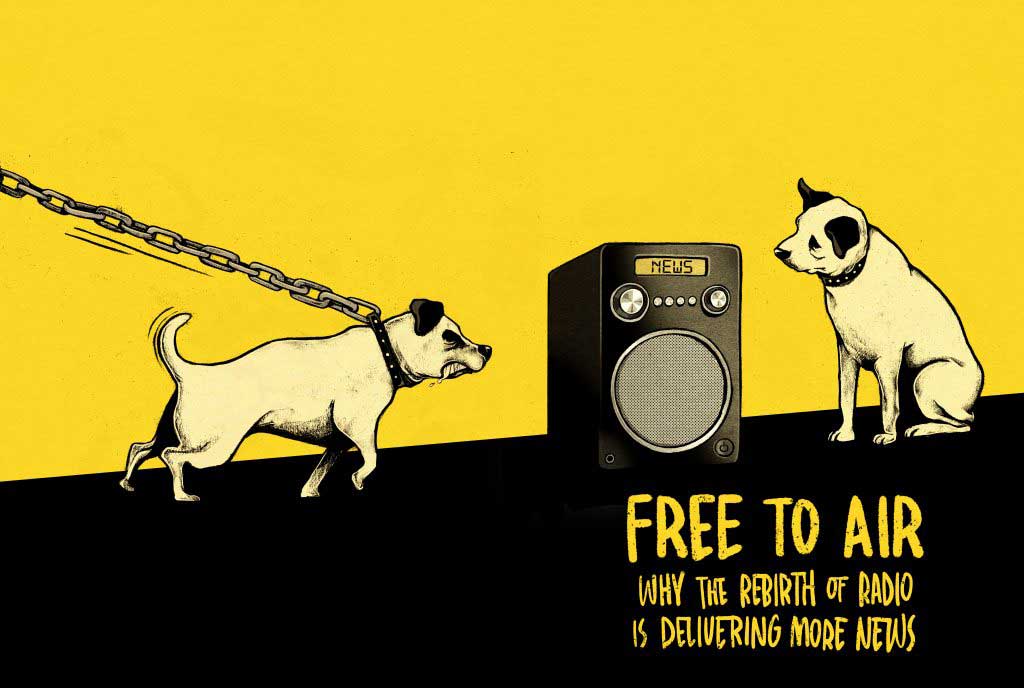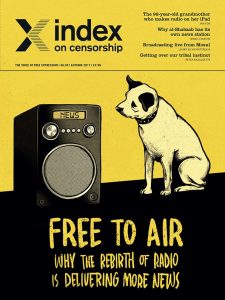28 Sep 2017 | Press Releases

Free to air is the autumn 2017 edition of Index on Censorship magazine
Mexico is among the world’s most dangerous places to be a journalist, with a record number of journalists being killed in Mexico this year. We explore this in the autumn issue of Index on Censorship magazine 2017, which features two excellent articles on the dangers journalists face in the country today.
In an in-depth exclusive for Index, Duncan Tucker writes: “A record 11 journalists were murdered in 2016, and 2017 is on course to surpass that grim tally.”
Tucker says that Mexico’s drug war has brought record murder rates in 2017 and that this trend looks set to only get worse, with next year’s elections likely to cause further instability across the country.
“More than 100 Mexican journalists have been murdered since 2000 and at least 23 others have disappeared.”
“According to the Committee to Protect journalists, 95% of those killed in direct retaliation for their work are reporters for publications, which are typically in remote regions where the rule of law is undermined by rampant crime and corruption.”
“While journalists from the capital can retreat to relative safety after reporting in hazardous areas, local reporters are constantly exposed to the consequences of their work.”
Several local journalists are interviewed in the article, including Adrian Lopez, editor of a newspaper in the state of Sinaloa, who says: “We need professional help to understand and talk more about these things and the trauma that the violence could cause us.”
Alejandro Hope, a security analyst, says: “Federal authorities have failed to properly investigate and prosecute these cases.”
In the second article in the magazine to spotlight Mexico, journalist Tim MacGabhann is interviewed about his fictional book, which follows the life of a non-Mexican journalist in Mexico, who is haunted by the ghost of a colleague, a Mexican journalist. MacGabhann, who has reported from Mexico for Al Jazeera, amongst other publications, spoke of the protection foreign correspondents are afforded in the country and how this protection is not extended to Mexican journalists. The ramifications of this are becoming more visible at present.
“As foreign correspondents we depend on the work of local reporters, as fixers, to read their stories, and yet they pick up the tab,” says MacGabhann, who was visibly shocked by the growing tally of dead journalists this year when interviewed.
“NGOs can get you a panic button, one that you wear around your wrist or at home, but lots of journalists don’t use them. They’re too afraid because the person threatening you is likely to be a cop and you’re not going to call the cops about the cops.”
MacGabhann also spoke of his tremendous respect for journalists who continue to report there. Despite the violence, journalists continue to write and expose the country’s crime and corruption. They would rather be killed than stop reporting,” said MacGabhann.
For more information on the situation journalists face in Mexico and to read these articles, alongside other articles spotlighting Mexican journalists this year, please contact Rachael Jolley, editor of Index on Censorship magazine at [email protected] or Jemimah Steinfeld, deputy editor, at [email protected]
Notes:
You can order your copy here, or take out a digital subscription via Exact Editions. Copies are also available at the BFI, the Serpentine Gallery, MagCulture, (London), News from Nowhere (Liverpool), Home (Manchester) and on Amazon. Each magazine sale helps Index on Censorship continue its fight for free expression worldwide.
About Index on Censorship magazine
Index on Censorship magazine was first published in 1972 and remains the only global magazine dedicated to free expression. Since then, some of the greatest names in literature and academia have written for the magazine, including Nadine Gordimer, Mario Vargas Llosa, Amartya Sen, Samuel Beckett, as well as Arthur Miller and Harold Pinter. The magazine continues to attract great writers, passionate arguments, and expose chilling stories of censorship and violence. It is the only global free expression magazine.
Each quarterly magazine is filled with reports, analysis, photography and creative writing from around the world. Index on Censorship magazine is published four times a year by Sage, and is available in print, online and mobile/tablets (iPhone/iPad, Android, Kindle Fire)
Winner of the British Society of Magazine Editors 2016 Editor of the Year in the special interest brand category.
As the Boston Globe said, Index has bylines that Vanity Fair would kill for. “Would that bylines were the only things about Index people were willing to kill for”
Subscription
19 Sep 2017 | Events, Volume 46.03 Autumn 2017 Extras
[vc_row][vc_column][vc_column_text]

Free to air is the autumn 2017 edition of Index on Censorship magazine
Join Index on Censorship magazine for the launch of the autumn 2017 celebrating all things radio.
In conjunction with our friends at Resonance FM, Index will be broadcasting all evening on Tuesday 10 October, as we discuss the rebirth of radio and why it is so important to freedom of expression.
Special guests include Jamie Angus, deputy director of the BBC World Service Group, broadcaster and DJ Tabitha Thorlu-Bangura from NTS Live, broadcaster and sound artist Fari Bradley from Resonance FM and writer and broadcaster Mark Frary, who will also be running a short DIY podcasting workshop before the panel discussion.
We’re launching the magazine with its special report Free to Air: Why the Rebirth of Radio is Delivering More News at the iconic Tea Building in Shoreditch, home to digital product studio ustwo, our venue partners for the launch. Features in the latest magazine include a 98-year-old granny making grassroots radio in the USA, radio journalists in Somalia who brave danger to do their jobs and the Spanish comedians who make a television show about a radio station.
There will be drinks from Flying Dog Brewery, our freedom of expression chums and sponsors and we’ll be closing the evening with a DJ set from Resonance FM’s very own Nana Nicol.
6:00 – 6:30 DIY podcasting workshop, register for your free space via [email protected]
6:30 – 7:15 drinks
7:15 – 8:30 Panel discussion
8:30 – 9:00 DJ set from Nana Nicol
Many thanks to:[/vc_column_text][vc_row_inner][vc_column_inner width=”1/3″][vc_single_image image=”95760″ img_size=”full” onclick=”custom_link” link=”https://resonancefm.com/”][/vc_column_inner][vc_column_inner width=”1/3″][vc_single_image image=”80918″ img_size=”full” onclick=”custom_link” link=”https://uk.sagepub.com/”][/vc_column_inner][vc_column_inner width=”1/3″][vc_single_image image=”95897″ img_size=”full” onclick=”custom_link” link=”https://ustwo.com/”][/vc_column_inner][/vc_row_inner][/vc_column][/vc_row][vc_row][vc_column][vc_column_text]
When: Tuesday 10 October 18:30 to 21:00
Where: ustwo London, 62 Shoreditch High Street, London E1 6JJ
Tickets: Free. Registration required via Eventbrite
[/vc_column_text][/vc_column][/vc_row]
18 Sep 2017 | News and features, Volume 46.03 Autumn 2017 Extras
[vc_row][vc_column][vc_custom_heading text=”In the Autumn issue of Index on Censorship magazine, we explore the censorship of the female nipple, which occurs offline and on in many areas around the world. We speak to photographers and magazine editors who are covering up and the women who are fighting against it, one nipple at a time.”][vc_column_text]
Part of the controversy lies in the double standard. Male nipples are totally fine, despite little to no difference in their appearance. With that in mind, we present to you a male nipple. You can cut this out and put it over a female nipple. Your nipples will then be ready to go out in public.
You can read more about the latest issue of the magazine here.
[/vc_column_text][/vc_column][/vc_row]
12 Sep 2017 | Press Releases, Volume 46.03 Autumn 2017 Extras

The autumn 2017 Index on Censorship magazine
The retro medium of radio is back, as we explore in the autumn issue of Index on Censorship magazine 2017, which is excellent news for the delivery of well, news.
“The new rise of radio allows more opportunities to discuss and debate than ever before, but we must also fight for radio stations to be unbound from state control and to be able to broadcast news freely,” Index on Censorship magazine Editor Rachael Jolley writes in the new issue.
Listen to a radio show, and you might be provoked, informed or excited about a new subject. But in listening you are doing something that is a little out of fashion, contemplating what others are saying, not tweeting some angry instant response, or even just posting the first thought that comes into your head.
After many predictions of its death, radio is on the rise again, its audience is growing across various age groups and various countries including the US and UK, and part of the reason might be because we are all a bit tired of transmitting constantly. Instead we appear to be happier to settle down and listen to radio and, particularly its news programmes, once again, argued Jolley.
We report that in the summer of 2017, around 48.2 million people in Britain listened to the radio at least once a week, up 0.9% from 2016. And in 2017 across the Atlantic, the USA is seeing a surge in listeners for news and talk radio. Of particular interest is the steady growth in those who listen to the radio for news in the 18-35 age group. “Radio was thought to be going out of fashion as new technologies elbowed it out of the way, but instead it’s back and gathering new audiences. Part of the reason might be growing awareness that someone’s ramblings are not necessarily a reliable source of information.”
Our special report on radio and its impact in 2017 includes a report from Laura Silvia Battaglia in Mosul on the radio station that is giving a voice to the residents of the city, while Claire Kopsky interviews people behind “radio boats”, which are broadcasting information on cholera in the Central African Republic in a bid to educate the population about the disease. We report on how Somali radio journalists receive threats from Al-Shabab for doing their jobs. “I check underneath my wheels, but normally they put bombs under the seat in your car,” says radio reporter Marwan Mayow Hussein.
Then there are the stories of radio proving a perfect outlet for people to share their most private inner thoughts and experiences, as radio star Wana Udobang writes about from a Nigerian context and best-selling author Xinran remembers back in China.
“Part of the increased popularity of radio is that it’s managed to evolve and we explore how podcasts are being made in some of the least likely – and most censored – places, such as China, and smuggled into North Korea.” The magazine also have a handy guide on making your own podcasts, for those with an idea.
But radio’s ability to reach the masses also means that this powerful tool can get into the wrong hands. Then there’s Rwanda, which two decades ago saw the airwaves being monopolised by voices promoting genocide. The country has moved on a lot, but radio there is still far from free. Veteran reporter Graham Holliday who has covered the country reports on the latest challenges.
And there’s interviews with BBC World Service English director Mary Hockaday, pirate radio DJ Allan Brando, Hong Kong broadcaster Hugh Chiverton and science presenter Robin Ince.
Outside the special report on radio, the magazine publishes a special investigation into the dangers faced by journalists in Mexico, by our special correspondent Duncan Tucker, who looks at how many reporters have been murdered since 2000, as 2017 looks to record the most killings for a decade.
Plus Orwell Prize winning journalist Iona Craig argues that encrypted apps are needed to give reporters in dangerous countries more security.
Notes:
You can order your copy here, or take out a digital subscription via Exact Editions. Copies are also available at the BFI, the Serpentine Gallery, MagCulture, (London), News from Nowhere (Liverpool), Home (Manchester), Calton Books (Glasgow) and on Amazon. Each magazine sale helps Index on Censorship continue its fight for free expression worldwide.
About Index on Censorship magazine
Index on Censorship magazine was first published in 1972 and remains the only global magazine dedicated to free expression. Since then, some of the greatest names in literature and academia have written for the magazine, including Nadine Gordimer, Mario Vargas Llosa, Amartya Sen, Samuel Beckett, as well as Arthur Miller and Harold Pinter. The magazine continues to attract great writers, passionate arguments, and expose chilling stories of censorship and violence. It is the only global free expression magazine.
Each quarterly magazine is filled with reports, analysis, photography and creative writing from around the world. Index on Censorship magazine is published four times a year by Sage, and is available in print, online and mobile/tablets (iPhone/iPad, Android, Kindle Fire).
Winner of the British Society of Magazine Editors 2016 Editor of the Year in the special interest brand category.
As the Boston Globe said, Index has bylines that Vanity Fair would kill for. “Would that bylines were the only things about Index people were willing to kill for”
More information
For more information, previews or quotes, contact [email protected]
Subscriptions



